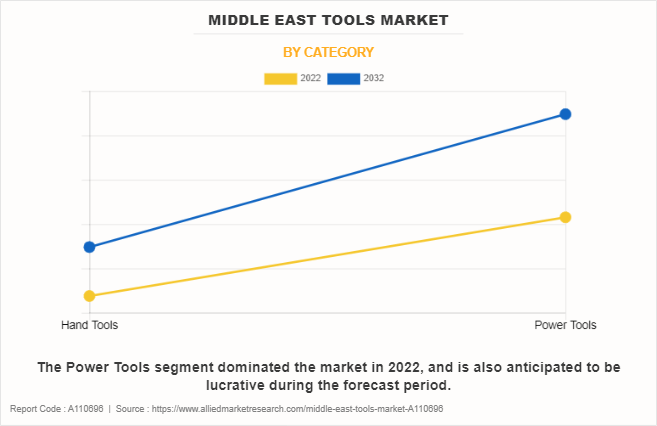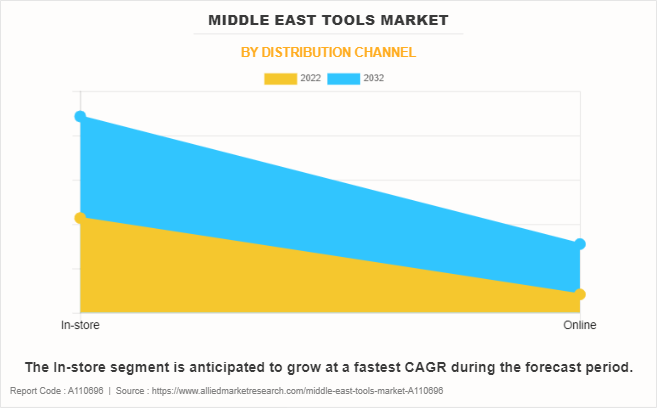The Middle East tools market is anticipated to witness significant growth during the forecast period. This is attributed due to the burgeoning construction and infrastructure development projects. In addition, the rapid urbanization and industrialization in countries such as the United Arab Emirates, Saudi Arabia, and Qatar fuels the growth of the market. In addition, the DIY culture, fostering a robust market for tools in the consumer segment contributes toward the growth of the market.
However, economic uncertainties, regional conflicts, and political instability can pose obstacles for the market growth. In addition, trade barriers and stringent government regulations pertaining to safety and quality standards hamper the growth of the market.

On the Contrary, the Middle East tools market is expected to offer several opportunities for new players in the market. The surge in awareness of the importance of safety in the workplace has led to increase in the demand for high-quality tools and offers remunerative opportunities for the market growth. The advent of new technologies, such as IoT-based tools are opening new avenues for innovation and product development. In addition, the increase in the focus on sustainability and environmentally-friendly tools offer lucrative opportunities for market players to create eco-friendly tools.
The Middle East tools market is set to witness several noteworthy trends and developments. Rise in shift toward more efficient and automated tools is the current trend. The rise of Industry 4.0 is expected to introduce smart power tools that can monitor their performance, provide real-time data, and enhance productivity. Another significant trend is the DIY segments in which enthusiasts are expected to embrace user-friendly, ergonomically designed hand tools. The demand for multipurpose tools that offer versatility in various applications is also expected to grow. In addition, online platforms are expected to become the preferred channel for DIY consumers, offering a wide range of product choices and convenience.

The Middle East tools market is segmented into category, distribution channel, and end-user. Based on category, the market is bifurcated into indoor hand tools and power tools. Furthermore, the hand tools segment is further categorized into striking tools, garden tools, and others. By the distribution channel, the market is divided into in-store and online. Depending on the end user, the market is classified into DIY (Do it Yourself), and industrial & commercial.
Qualitative developments are pivotal in understanding the insights of the Middle East tools market. This includes new product development, R&D, pricing strategies, and consumer and end-user perceptions. Market players are focusing on new product development and investing in creating tools that are more efficient, durable, and sustainable. Companies are investing in R&D to provide cutting-edge technologies. Understanding consumer and end-user perceptions is crucial as consumers are more aware of the quality and safety of tools. Market players often adopt competitive pricing strategies to gain market share.

The Porter’s five forces analysis is a model, which analyzes the competitive scenario of the industry and role of each stakeholder. The five forces include the bargaining power of buyers, the bargaining power of suppliers, the threat of new entrants, the threat of substitutes, and the level of competitive rivalry. The bargaining power of suppliers often holds significant bargaining power. The market relies on a global supply chain for steel, plastics, and electronic components. Suppliers' ability to maintain consistent quality and timely delivery can influence market dynamics. The bargaining power of buyers is moderate to high bargaining power due to the presence of a wide range of choices and can exert pressure on prices and product specifications.The threat of new entrants is low due to high capital requirements, established brand presence, and the need for compliance with stringent safety and quality standards. The threat of substitutes is moderate as the traditional hand tools face competition from power tools and vice versa, the broad range of applications and unique features of each type of tool mitigate the substitute threat. The level of competitive rivalry is intense due to the presence of several established players and regional manufacturers competing for market share.
A SWOT analysis provides an overview of the Middle East tools market. It includes its internal strength, weakness, opportunities and threats. The strengths include strong demand driven by construction, infrastructure, and industrial projects, rise in DIY culture and consumer awareness of tool quality, increase in the investment in R&D for innovative products, established brands with a strong presence in the region. The weaknesses include vulnerability to economic fluctuations and political instability, high dependence on oil revenues, affecting consumer spending, stringent regulations and trade barriers in some markets, and environmental concerns driving the need for sustainable tools. The opportunities lie in the increase in focus on safety in the workplace, driving demand for high-quality tools, emerging technologies like IoT and AI for smart tools, rise in consumer interest in eco-friendly and sustainable tools, and expanding online distribution channels for a wider reach. The threats include economic uncertainties and regional conflicts impacting market growth, fluctuations in global oil prices affecting consumer and industrial spending, competition from regional and global tool manufacturers and stringent regulatory requirements challenging market entry.
The key players operating in the Middle East tools market are Stanley Black & Decker, Bosch, Makita, Snap-on, Hilti, Würth Group, Ryobi, TTI Group, DeWalt, and Atlas Copco.
Key Benefits For Stakeholders
- Enable informed decision-making process and offer market analysis based on current market situation and estimated future trends.
- Analyze the key strategies adopted by major market players in Middle East tools market.
- Assess and rank the top factors that are expected to affect the growth of Middle East tools market.
- Top Player positioning provides a clear understanding of the present position of market players.
- Detailed analysis of the Middle East tools market segmentation assists to determine the prevailing market opportunities.
- Identify key investment pockets for various offerings in the market.
Middle East Tools Market Report Highlights
| Aspects | Details |
| Forecast period | 2022 - 2032 |
| Report Pages | 73 |
| By Category |
|
| By Distribution Channel |
|
| By End User |
|
| Key Market Players | DEWALT, Snap-on Incorporated, Makita Corporation, Greenlee Textron Inc, Stanley Black & Decker, Apex Tool Group, Harbor Freight Tools, Bosch Group, IRWIN Industrial Tool Company, Canadian Tire Stores Limited |
The Middle East Tools Market is projected to grow at a CAGR of 5.8% from 2022 to 2032
Stanley Black & Decker, Bosch Group, Makita Corporation, Snap-on Incorporated, DEWALT, IRWIN Industrial Tool Company, Greenlee Textron Inc, Canadian Tire Stores Limited, Harbor Freight Tools, Apex Tool Group are the leading players in Middle East Tools Market
1. Enable informed decision-making process and offer market analysis based on current market situation and estimated future trends.
2. Analyze the key strategies adopted by major market players in middle east tools market.
3. Assess and rank the top factors that are expected to affect the growth of middle east tools market.
4. Top Player positioning provides a clear understanding of the present position of market players.
5. Detailed analysis of the middle east tools market segmentation assists to determine the prevailing market opportunities.
6. Identify key investment pockets for various offerings in the market.
Middle East Tools Market is classified as by category, by distribution channel, by end user
Loading Table Of Content...
Loading Research Methodology...



